Drumroll, please... We've reached the grand finale of the Turkish Black Sea Cuisine series. For this final installment, we're heading a bit further east along the coast to explore two incredible cities that completely took me by surprise, Trabzon and Rize.
But first, if you haven’t caught up on the previous articles in the series, here they are:
A Taste of Nostalgia: A personal reflection on my recent culinary trip to the Black Sea.
At the Crossroads of Sea and Soil: A broader historic and gastronomic look at the Turkish Black Sea region.
The Cuisine of Sinop and Kastamonu: A closer look at two coastal cities and the bites and sips that left an impression.
Perhaps it was because I'd few expectations, or because we’d been cooped up at home for a year and a half due to COVID-19 isolation, but I never anticipated just how deeply I’d fall in love with Trabzon and Rize. Before Salih and I moved from Turkey to the U.S., we had dreamed of exploring the Turkish Black Sea, so in a somewhat spontaneous decision, we set off, unaware that it would soon become one of our all-time favorite trips.
As soon as we landed, the difference was striking. We had left behind the warm, sun-drenched charm of İzmir and arrived in the cool, misty embrace of Trabzon. Rain met us as we stepped off the plane, carrying a gentle chill. It was just as I had imagined, moody skies and lush, rolling hills.
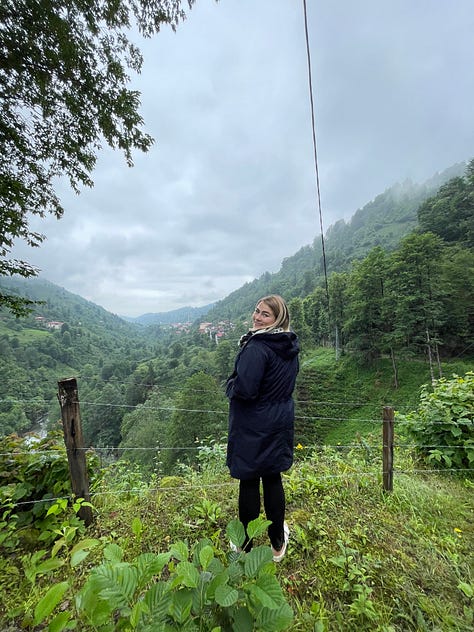


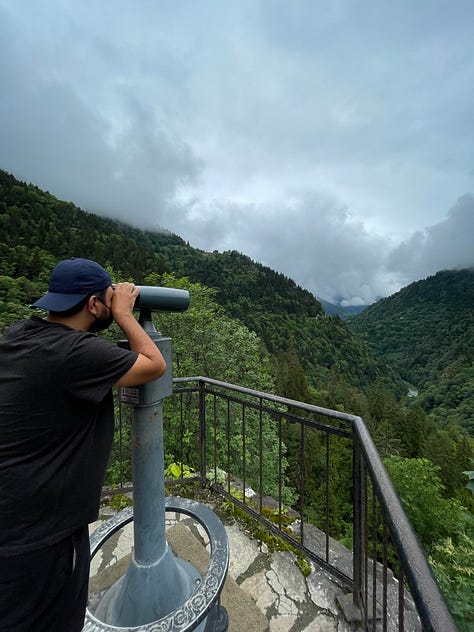
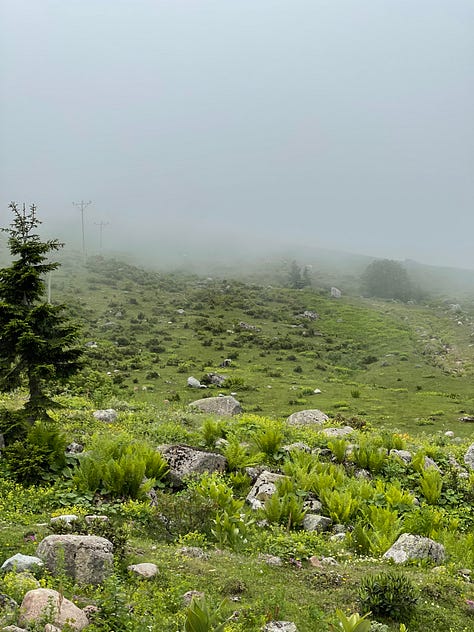

We picked up our rental car and set out; to our left, the Black Sea and to our right, mountains rose steep and green. We made a brief stop in Trabzon to eat lunch at Kalkanoğlu Pilavı, the oldest restaurant in Trabzon, open since 1856. Its weathered stone walls and wooden beams held history, setting the tone for the meal to come.
The restaurant began during the Ottoman-Russian War of 1853. At the time, soldiers stationed in Trabzon were fed little more than pilaf, bread and hoşaf, which is a dessert with dried fruits like raisins, dried prunes, apricots and figs boiled in water with sugar and left to cool. Seeing the need for better meals, the governor requested a master rice cook from the Sultan, enter Süleyman Ağa, known as Kalkanoğlu, whose pilaf the Sultan already loved.
Süleyman Ağa began cooking for the army and his pilaf became so popular that the governor ordered it be shared with the public. What began as a soup kitchen later evolved into this restaurant, where, in the name of fairness, portions were measured by scale, a tradition still honored today (Kısık Ateş Akademi).
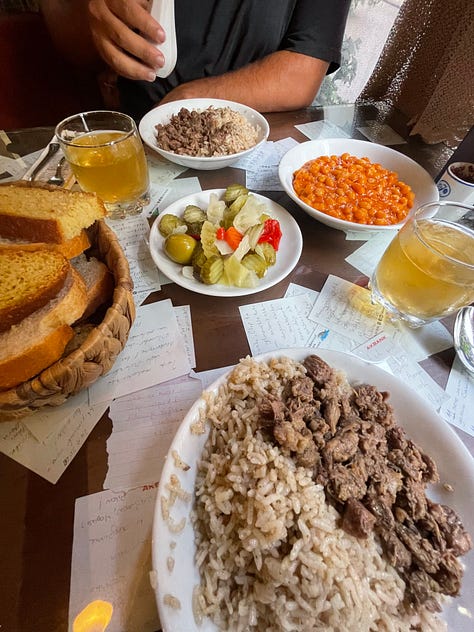

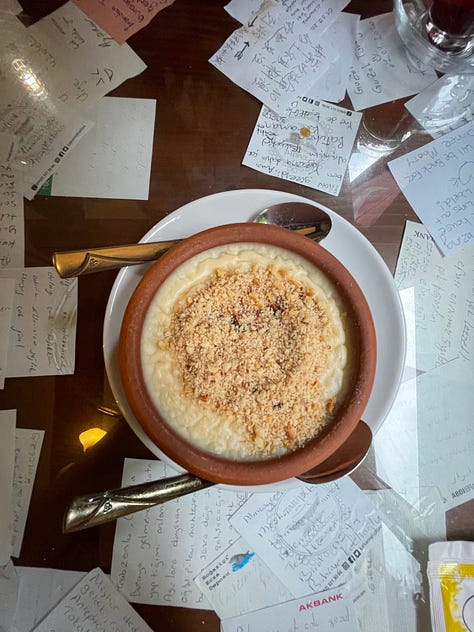
Here, we had our first true taste of the region’s essential flavors. The table filled quickly with simple dishes: golden cornbread, pickled vegetables, slow-simmered beans, kuru fasulye, rustic plates of rice pilaf with tender meat, kavurma, and creamy sütlaç, a baked rice pudding blanketed in crushed hazelnuts. It was a perfect introduction to what lay ahead.
We got back on the road and drove for another hour or so toward Rize. As we followed the coastal highway, something quickly caught our attention. On every road sign pointing to Rize, the Turkish text was immediately followed by Arabic. We had never seen so much Arabic on municipal signage in Turkey before. It was a clear sign that this region had a strong presence of Arabic speakers, both residents and visitors.
As we continued eastward, the landscape began to shift. The mountains grew steeper, rising dramatically from the sea and the vegetation became lusher, deeper in color.
We had booked our hotel without realizing it was perched high atop a mountain. The Dudi Konak Hotel, charming in every other respect, came with one major surprise: the road leading to it. Calling it a road feels generous; it was more like a winding path carved into the side of a cliff and it still gives me chills to think about.
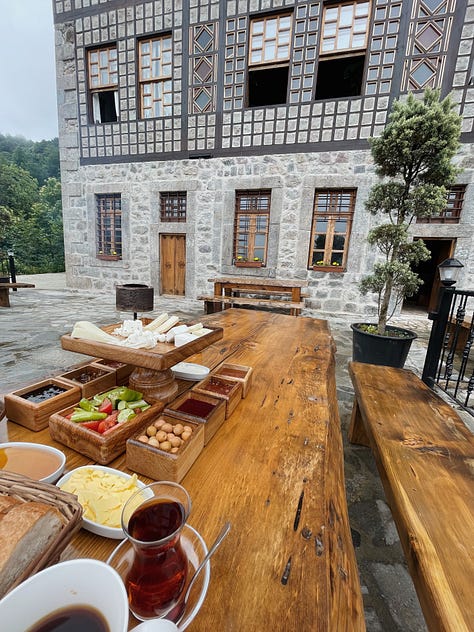
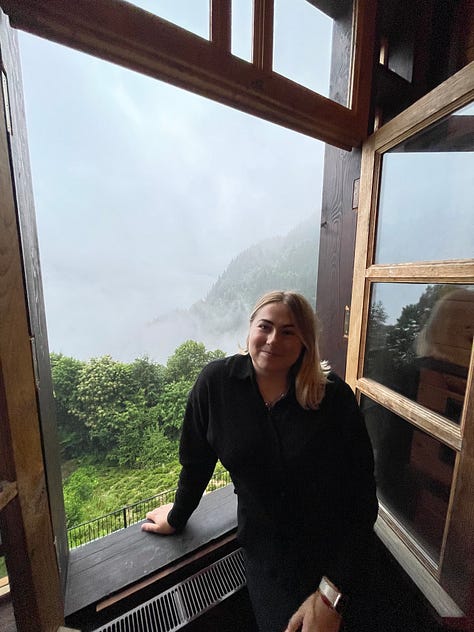
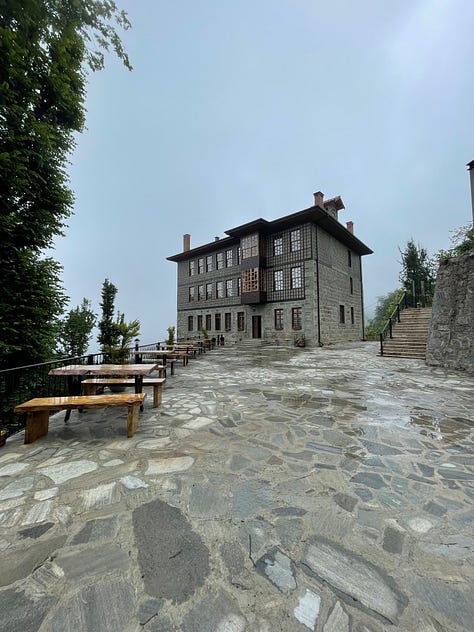
As Salih navigated the turns with calm precision, I sat beside him in a state of near-panic, gripping the door handle like a lifeline. Each time we drove up or down, I felt as if we were just one sneeze away from plummeting off the edge. It was the kind of experience that unlocked a new, very specific fear.
Maybe the road has been paved since then, I’d like to believe that. But the truth is, if you’re driving in Rize, this kind of terrain is par for the course. The region is made of mountains, steep, wild and stunningly green. The roads, often unpaved and clinging to hillsides, come with the territory. It’s all part of the adventure, though I’ll admit, it almost made me forget how lovely the hotel itself actually was.
The Climate That Defines the Land
Rize sits at the base of the Kaçkar Mountains, the easternmost part of the Pontic Mountain range that runs parallel to the Black Sea. The city has a humid subtropical climate where winters are mild, summers are warm and rain falls in abundance year-round, making Rize one of the wettest places in Turkey, which makes it the ideal place for growing tea.

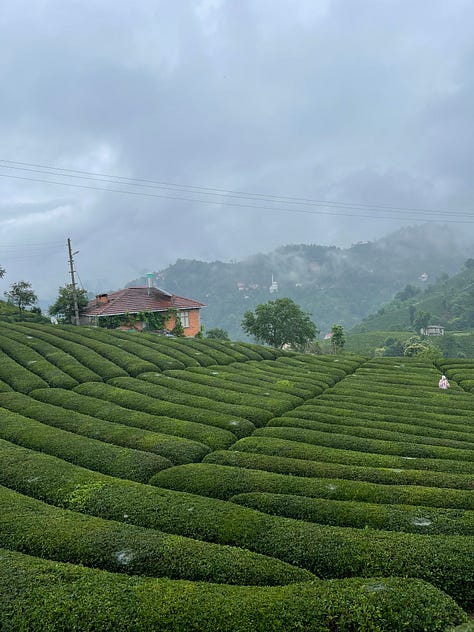
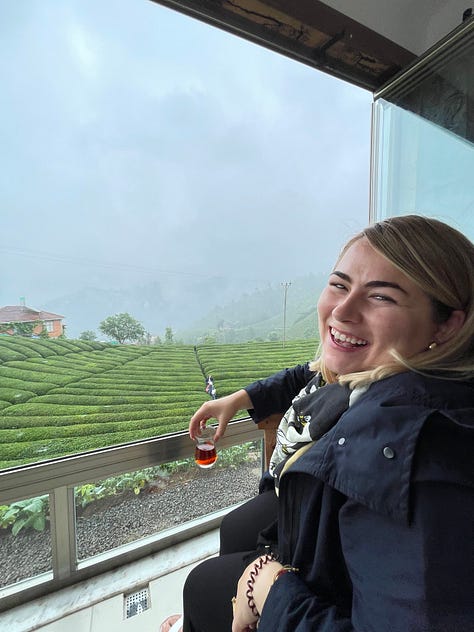
The Role of Çay in the Turkish Economy
Black tea, known as çay in Turkey, is a cornerstone of daily life, especially in Rize, but truly throughout the entire country. Today, Turkey holds the highest per capita tea consumption in the world, averaging around 1,300 cups per person each year (Food Navigator Asia). Çay is deeply woven into social life, hospitality and everyday sustenance, but this wasn’t always the case.
After the founding of the Republic of Turkey in 1923, Mustafa Kemal Atatürk, the founder of the nation, encouraged tea cultivation in the eastern Black Sea region as part of a broader strategy to strengthen domestic production, reduce reliance on imports and stimulate economic self-sufficiency. Significant investment was made in çay production and by the 1960s, Turkey had not only met its domestic tea demand but had also begun emerging as a notable player in the global tea export market (T Ching).
If you’re visiting Rize, I highly recommend spending time in a tea field. The region is full of mountain farms with terraced tea gardens climbing up steep hillsides. Many places offer the chance to sip a fresh cup of tea while learning about the tools farmers use to harvest the leaves, like the specialized clippers and traditional baskets. One of our favorite tea producers is Lazika, a local brand with a charming café where you can learn more about their approach to tea cultivation and production.
Many visitors travel to Trabzon and Rize not just for the sea views and tea fields, but to experience the breathtaking yayla, the highland meadows that dot the Kaçkar Mountains. These alpine pastures, with their rolling green hills, wildflowers and misty air, offer an almost Swiss-like beauty, earning the region comparisons to the Alps. In summer months, locals and nomadic herders bring their animals up to these highlands, a tradition known as yayla göçü, creating a seasonal rhythm of pastoral life that’s been part of the Black Sea culture for centuries. The meadows are also home to traditional wooden houses, grazing livestock and cool breezes, making them an ideal escape from the heat and bustle of the cities below.
Indigenous Groups: The Laz and Hemşin People
In the northeastern region of the Turkish and Georgian Black Sea, you’ll find the Laz people, an indigenous ethnic group also known as the Lazuri. With their own distinct language, dress, music, dance (horon folk dance), cuisine and social traditions, Laz culture remains influential in the region today. Traditional instruments like the tulum (a type of bagpipe), daira (a tambourine) and zurna (a woodwind instrument similar to an oboe) are used in celebrations and community gatherings. While many Laz in Turkey have gradually assimilated into the broader national identity, they continue to carry a unique cultural legacy.
The Hemşin people, also known as the Hemşinli, are an ethnic group with roots in Armenian heritage who settled in the Turkey’s mountainous regions, particularly around Rize and Artvin. Historical accounts suggest that they migrated to this area during the Middle Ages, likely to escape waves of Arab invasions in their original homeland. Over time, the Hemşin developed a distinct cultural identity, shaped by their Armenian ancestry, the geography of the Black Sea and centuries of coexistence with neighboring communities. Today, the Hemşin people are known for their unique language dialects (some still speak Hemşince, an Armenian dialect), vibrant folk music, distinctive headscarves and deeply rooted agricultural traditions (1, 2, 3).
Food of the Region
During our time in Trabzon and Rize, it quickly became clear that corn is a staple of the Turkish Black Sea’s culinary identity. Cornbread accompanies most meals, but unlike the soft, fluffy wheat-based breads common in other parts of Turkey, Black Sea cornbread is dry, dense and deeply tied to the region’s climate and traditions. Another beloved corn-based dish is muhlama, a rich and stretchy breakfast food made from cornmeal, local cheese and butter (pictured below). We enjoyed it twice during our stay in Rize, but our favorite experience was on a hike, when we stopped at a trailside, home-style restaurant and watched as the cook prepared it fresh right in front of us.
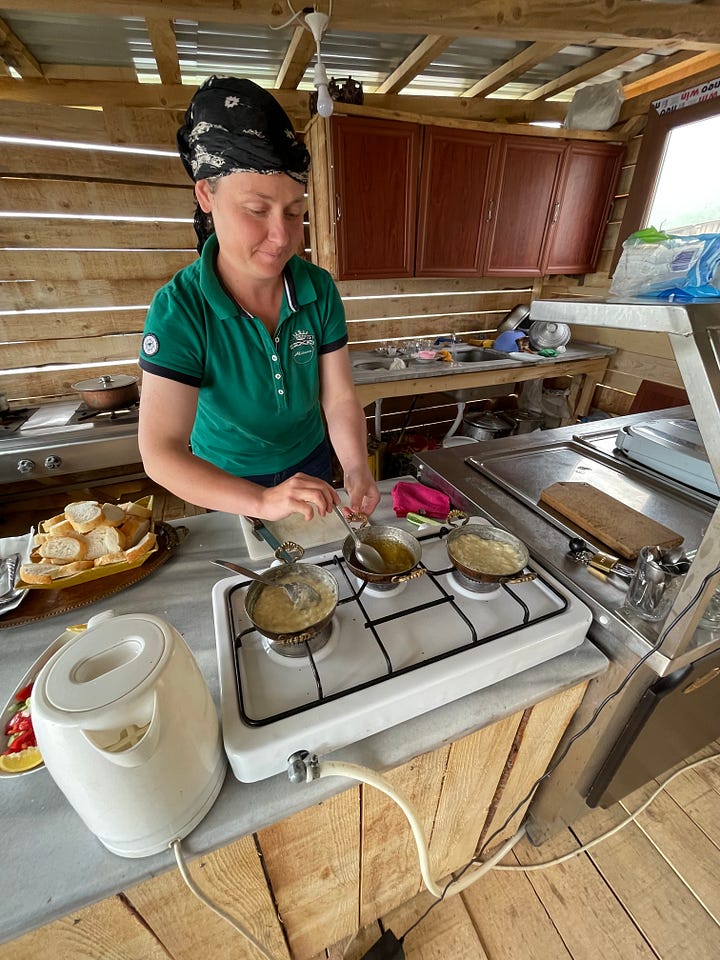
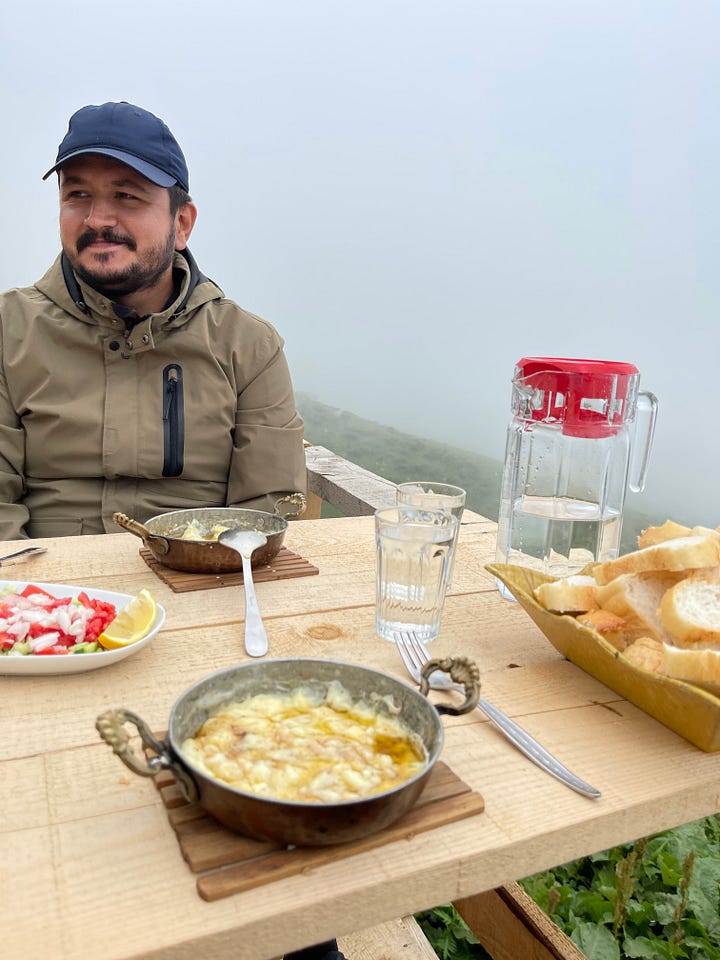
The region relies on butter rather than olive oil as its fat of choice. Dairy, in general, plays a prominent role in the local diet, with a variety of distinctive cheeses made from goat, cow and sheep milk. One of the most iconic is kolot peyniri, a mild, slightly tangy cheese traditionally used in muhlama. Many local cheeses are still produced in small-scale dairies or in highland pastures, known as yayla in Turkish, during the summer months, where animals graze on wild herbs and grasses, giving the dairy products a distinctive aroma and depth of flavor.
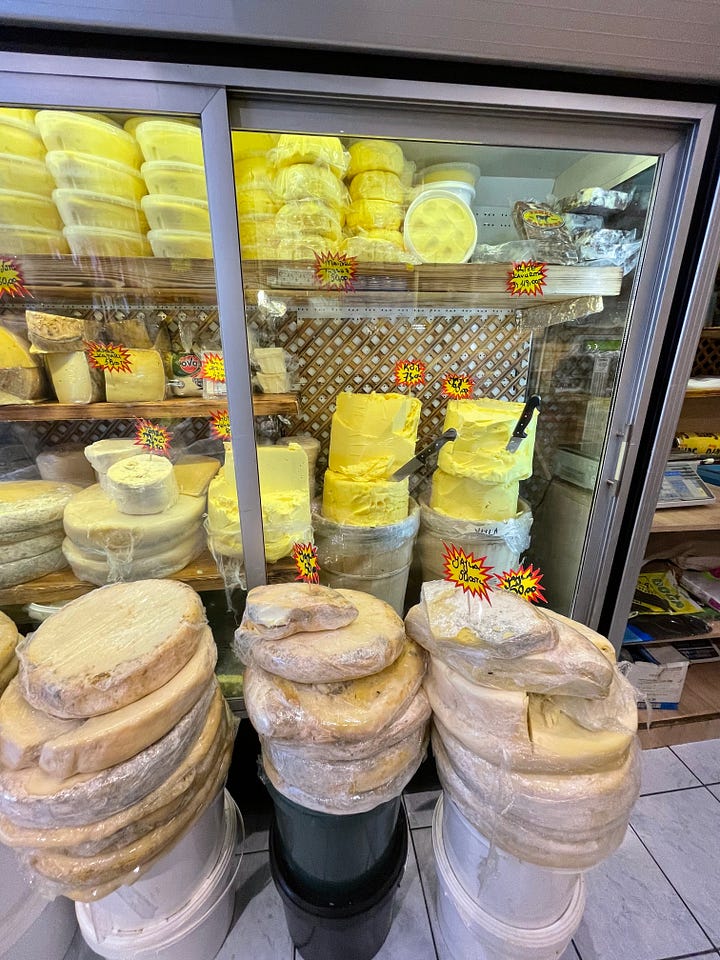

Winding through the tea fields of the Black Sea, we often spotted sturdy cabbage plants and climbing bean vines growing in small garden plots. These two ingredients, beans and cabbage, are staples of local cooking, shaped by the region’s damp, cool climate and self-sufficient lifestyle. In village homes, they find their way into everything from tangy pickles, turşu, to rich soups like karalahana çorbası, a cabbage and cornmeal stew often simmered with beans. Simple, filling and rooted in tradition, these dishes tell the story of a cuisine built on what the land reliably gives.

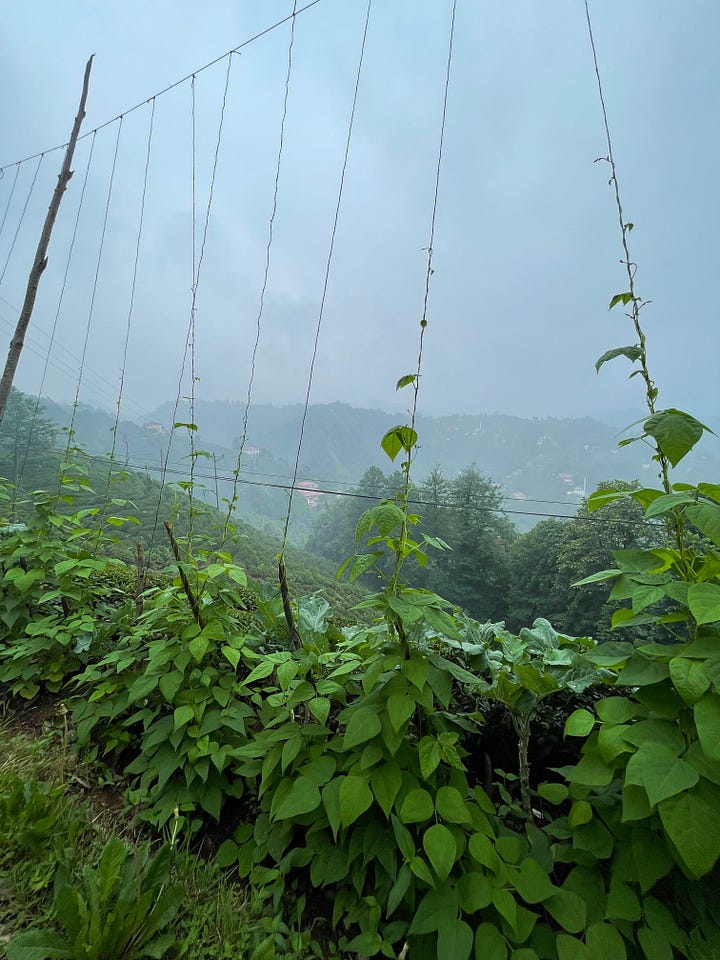
Hazelnuts, fındık, are one of the most important crops in the region, economically, culturally and agriculturally. Turkey is the world’s largest producer and exporter of hazelnuts and most of that production comes from the steep coastal hillsides of the eastern Black Sea.
The terrain and humid climate of the region are perfectly suited for hazelnut trees, which thrive on the sloped land where other crops might struggle. For many farming families, hazelnuts are a vital source of income, harvested by hand each summer, then sold to cooperatives or private companies, including major global buyers like Ferrero (maker of Nutella). In many villages, the hazelnut harvest is a community event, drawing families together for weeks of labor-intensive work.
Culinarily, hazelnuts show up in sweet and savory dishes alike. They’re used to enrich baklava, ground into spreads, folded into cookies or cakes and sometimes even toasted and added to pilafs or mezes. In the Black Sea kitchen, hazelnuts are more than a garnish; they’re a reflection of the region’s deep ties to the seasonal rhythms of rural life.
A Coffee Break Between the Tea Fields
Two cafés you shouldn’t miss in Rize are Noğa Cafe and Zua Coffee. Both are run by Turks who left big cities like Istanbul to embrace the slower pace and natural beauty of the region. These spots not only serve excellent coffee but also feature unique dishes that highlight local Black Sea ingredients and culinary traditions, blending creativity with a deep sense of place.
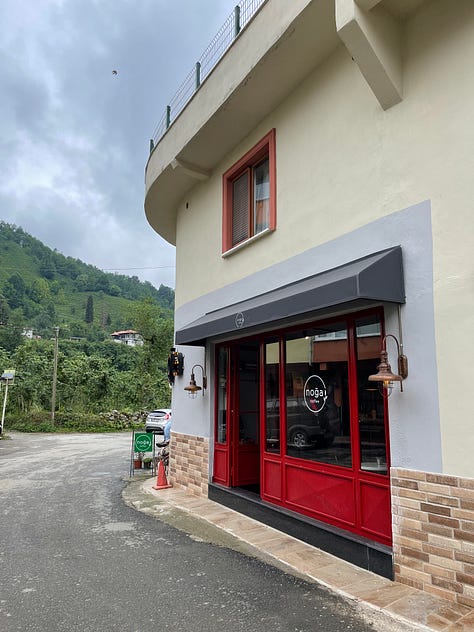
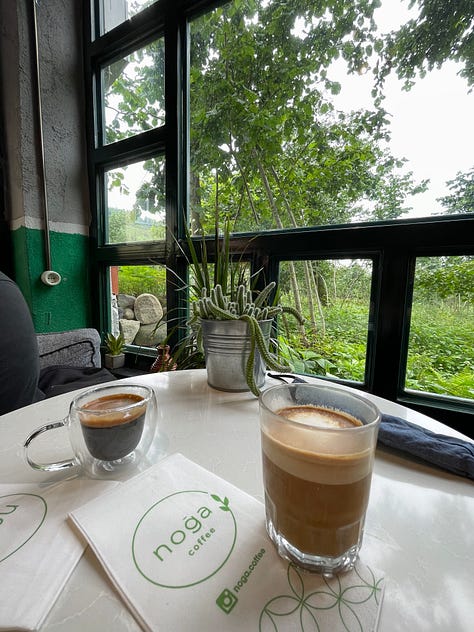


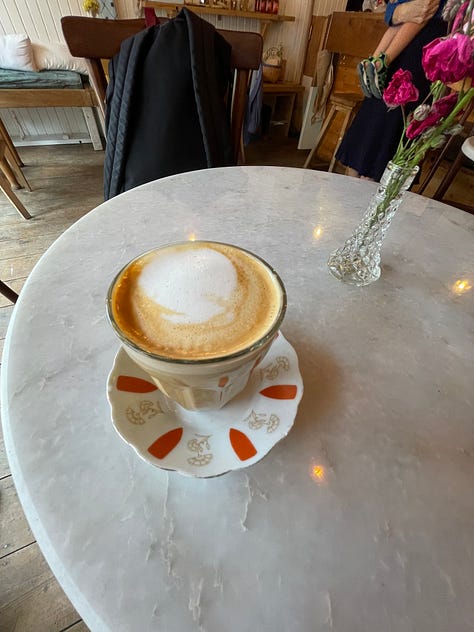

One of the best meals we had was at Mora, a cozy café and shop that’s now also home to beautifully designed short-term rentals. Their menu offers comforting Black Sea dishes made with regional ingredients and touches of Georgian influence. One standout was the Georgian-style mantı, larger than the Turkish version and bursting with rich, savory flavor. Mora is the kind of place that captures the warmth and depth of the region’s food culture in every bite.
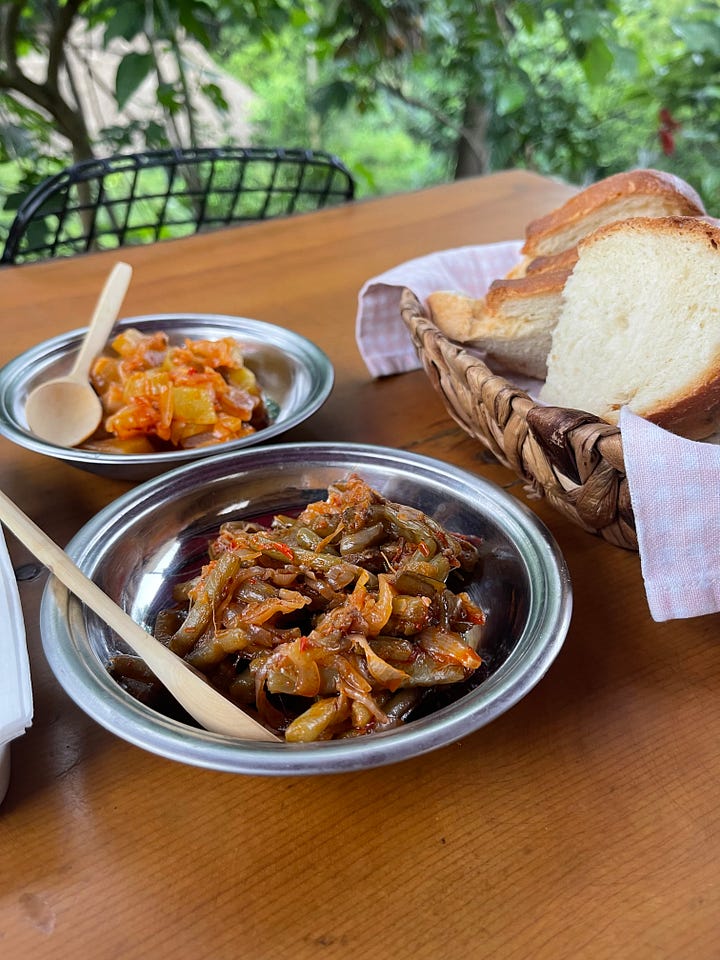
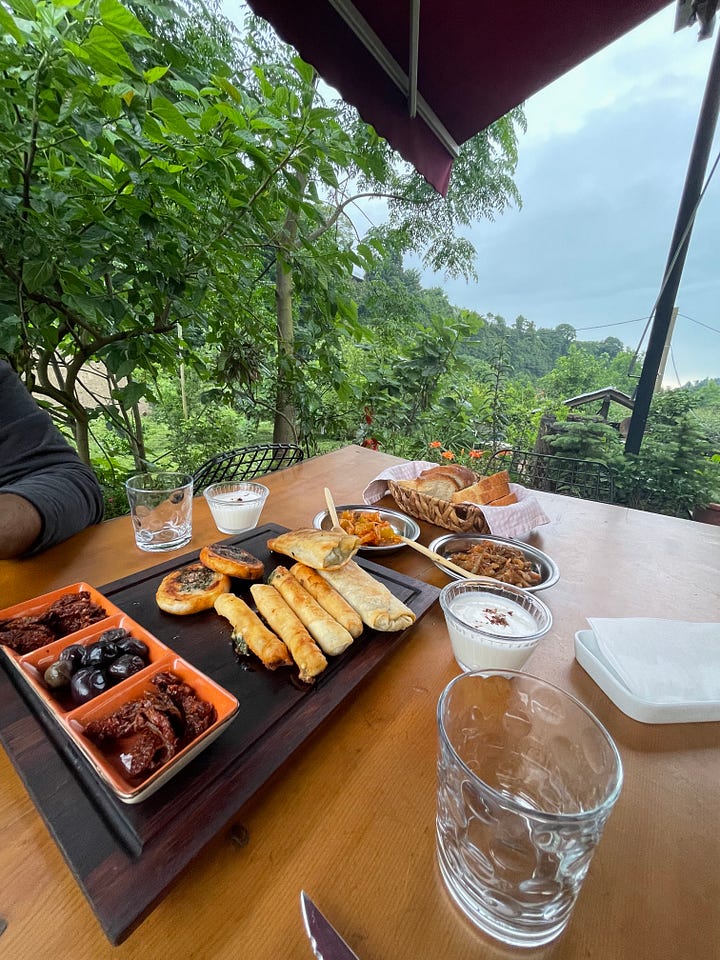


As Salih and I were wrapping up our time, we unexpectedly came across a salmon farm nestled along the coast. The design of the production facility and its scenic restaurant overlooking the water suggested business was thriving. Curious, we did a bit of digging and I’ve since learned that the Black Sea has quietly become a significant hub for salmon farming.
With its cool, clean waters and ideal environmental conditions, the region has attracted growing investment in aquaculture, positioning Turkey as an emerging player in global salmon production. It was one of those moments where a casual discovery opened the door to a much bigger story happening just below the surface. While this brings revenue to the region, it has also sparked concerns among local villagers about the potential ecological impact.
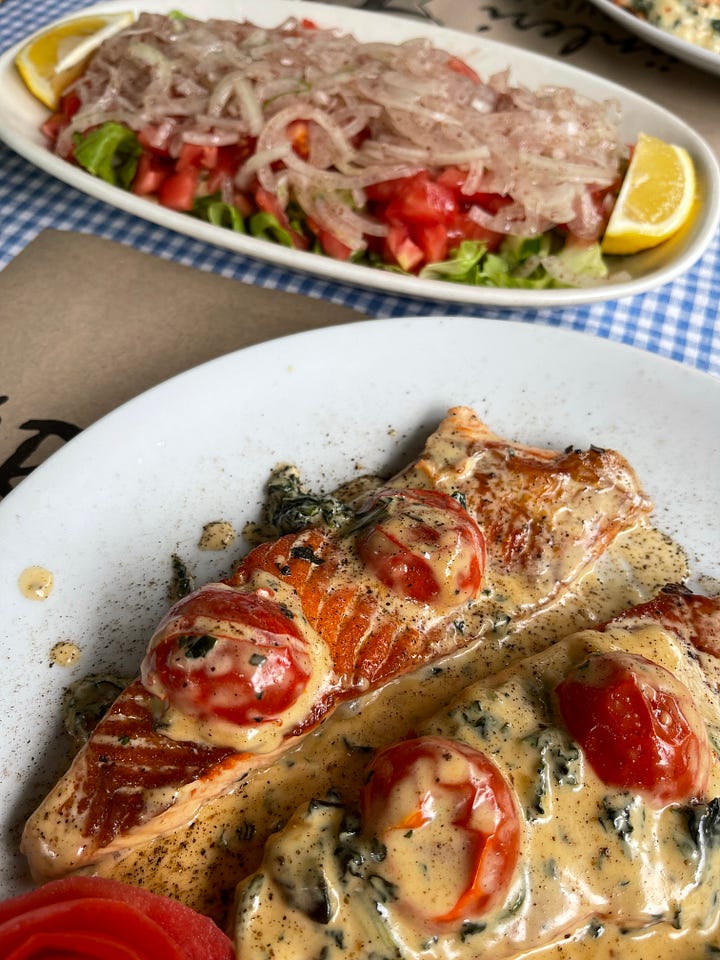
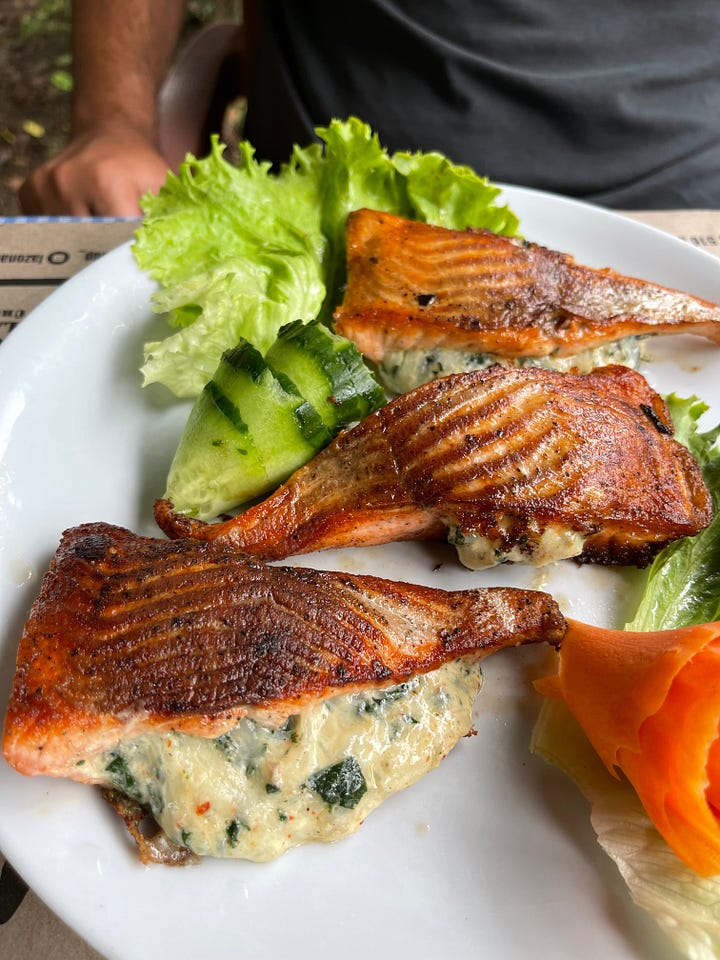
Exploring All the Region Has to Offer
While the food of the Turkish Black Sea is truly incredible, the region’s outdoor adventures are just as unforgettable. Salih and I ended up white water rafting with one of the 2018 Turkish national rafting champions, a thrilling, heart-pounding ride through the rushing rivers that carve through Rize’s lush valleys. It was wild, a little chaotic and completely exhilarating.
Beyond rafting, the region is a playground for nature lovers. You can hike through alpine meadows, fish in clear mountain streams or kayak down winding rivers. One highlight was exploring the remnants of Rize Castle tucked into the cliffs. Scattered throughout the landscape are centuries-old Ottoman-style stone bridges, standing strong and arching dramatically over rivers and ravines.
While we were there, we kept pinching ourselves at the beauty, the cultural richness and the quiet wonder of it all. This region is popular with Turkish travelers and some visitors from the Arab world, but it still feels off the radar for most of the globe. And honestly, I think that’s part of its magic. The people here seem to prefer it that way and after experiencing it for ourselves, we do too.





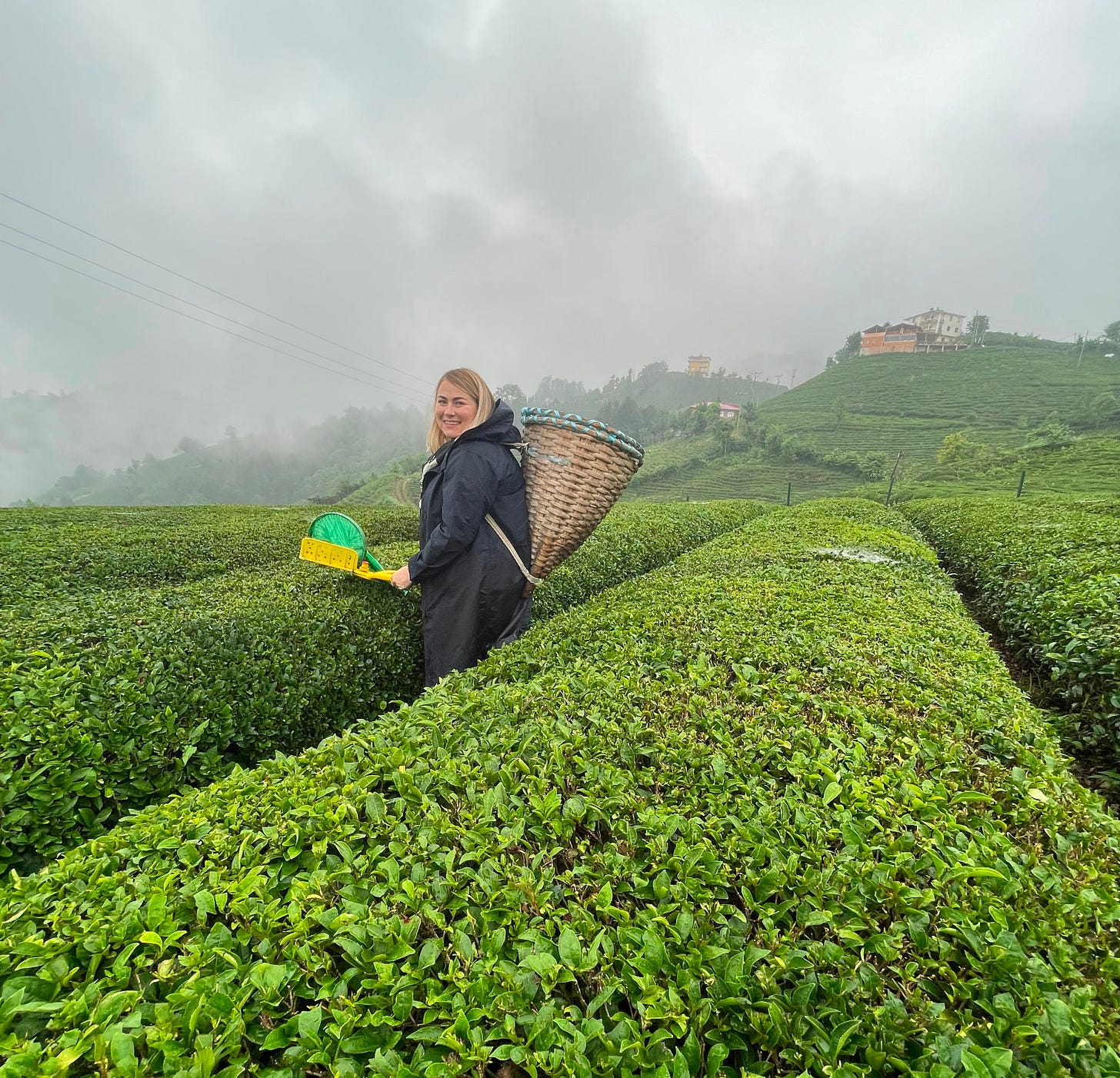
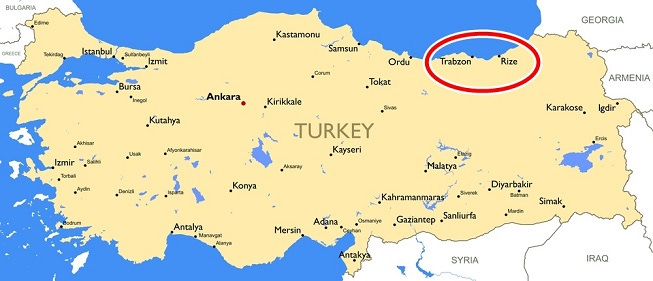

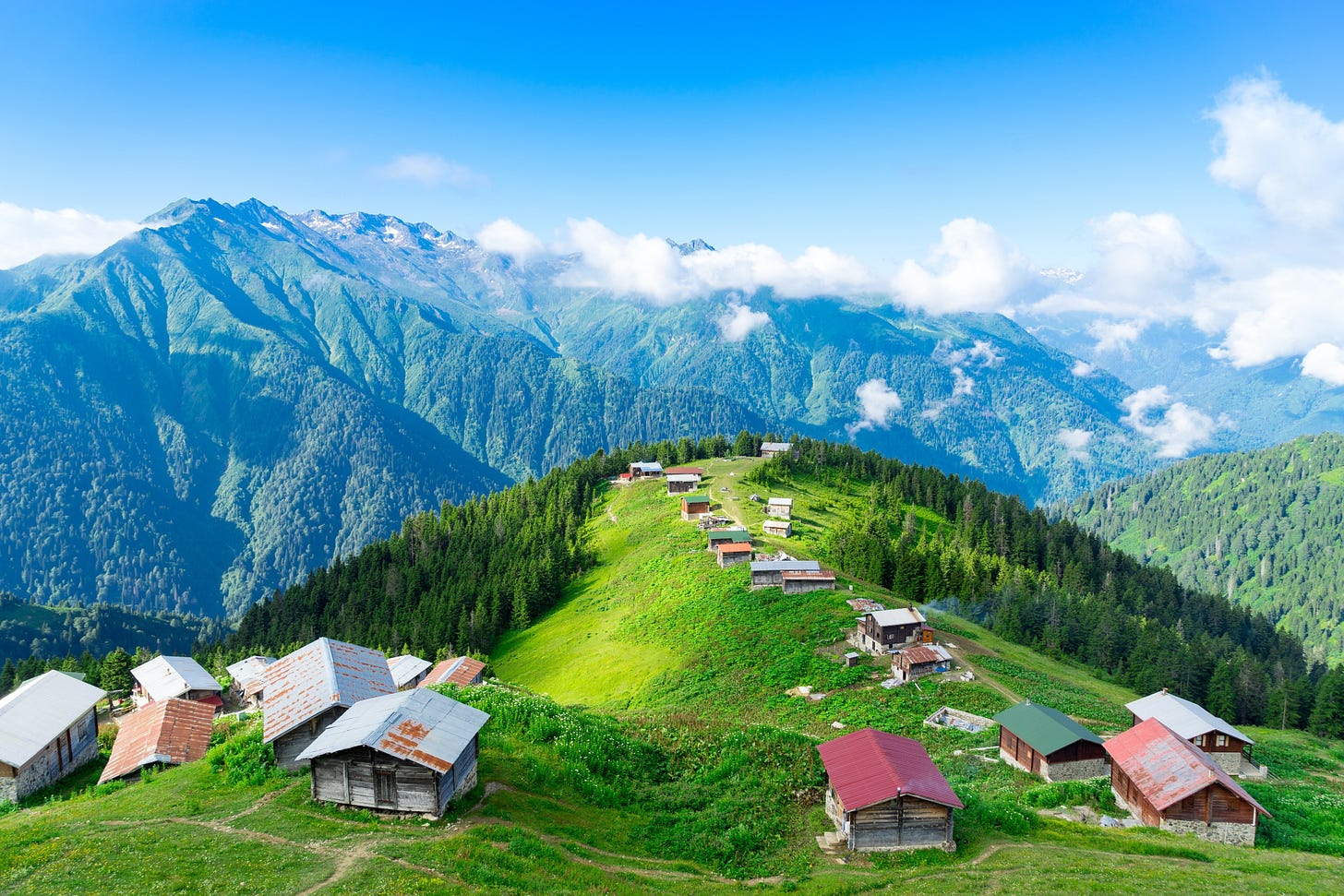



This piece has my mouth watering and my heart quickly dreaming of when I might be able to travel to this region again! we spent a few days here in June 2017, but honestly don't think I really got to experience Rize/Trabzon with anywhere as much delight as you all did! BUT I do remember the "yayla" we visited and it was truly other-worldly.